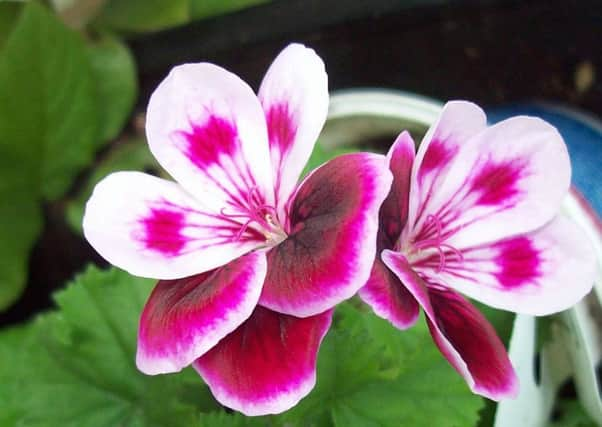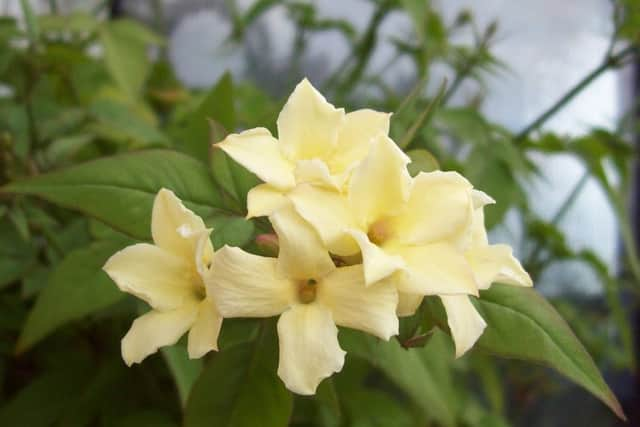Don't overlook power of scent in the garden
This article contains affiliate links. We may earn a small commission on items purchased through this article, but that does not affect our editorial judgement.


In this case, it’s jasmine Clotted Cream in a large container at the conservatory door – even better when the overpoweringly good tuberose flowers inside at the same time.
Scent is so often overlooked in gardens, yet it does so much to improve the mood and calm the mind. Herb, cottage and Mediterranean-style gardens are the obvious examples including fragrance, mainly from aromatic leaves and old varieties, such as lavender or roses.


Here are plants I use (or have grown in the past).
Advertisement
Hide AdAdvertisement
Hide Adl Scented leaved geraniums (Pelargonium odorata): Attar of Roses is an old variety from 1900, which smells like Turkish Delight, as is Clorinda, introduced in 1907, with large rose-pink flowers and cedar-scented leaves. Newer varieties include Angel’s Perfume, a combination of angel pelargoniums with a lemon aroma, Cola Bottles Torento, with gingery cola foliage scent and Lemon (Citriodorum), which has a zesty lemon aroma.
l Jasmine Clotted Cream (Jasminum officinale): A cream form of the common jasmine, but with larger flowers and even more fragrance. it’s supposed to need winter protection but has survived for a few years in a large pot in a sheltered position.
l Tuberose (Polianthes tuberosa): Mexican bulb producing spikes of creamy-white flowers, with the strongest scent of anything I’ve grown. It’s in the conservatory and when in bloom, a wall of scent hits you when you open the door.


l Roses: Desdemona has an intense myrrh fragrance; climber James Galway a traditional old rose perfume (also good in shade) and climber Claire Austin smells of myrrh, meadowsweet and vanilla.
Advertisement
Hide AdAdvertisement
Hide Adl Sweet peas: So many good varieties but the best for fragrance that I’ve grown are the mixtures Fragrantissima and Old Spice and the heritage variety Cupani. This has smaller blooms, but in an intense purple/burgundy red.
Bronze fennel: A herb with strongly-scented filigree aniseed foliage. A delight to let set seed around the garden – great contrast to almost everything.
l Sweet rocket: Another self-seeder which predates me in the garden. Lilac and white sweet-smelling biennial in early summer – when blooms are going over, I leave a couple to seed for next year.


l Tulips: Early scent comes in the form of species tulip Tulipa tarda (white and yellow), orange/purple Prinses Irene and yellow Yokohama.
Advertisement
Hide AdAdvertisement
Hide Adl Daffodils: I only grow perfumed varieties – Minnow, Pacific Coast, Tete a Tete, Thalia and Sundisc – my favourite for scent is Sweetness.
l Lavender: A large Hidcote lives by the path, meaning you can’t help brush past it, releasing the scent – and bees, unfortunately.
JOBS FOR THE WEEKEND


Watering is essential. Try to use grey water wherever possible, especially as water butts may be running low. It’s traditionally holiday-time, so you might need to bribe friends and family to look after the garden while you are away.
Don’t neglect hanging baskets – deadheading, watering and feeding will help them last through until autumn.
Advertisement
Hide AdAdvertisement
Hide AdDeadhead plants such as Dahlia and Penstemon and bedding to prolong the display colour well into early autumn.
Hardy geraniums can be cut back a little to remove tired leaves and encourage a new flush of growth.
Alpines that have developed bare patches of die-back, or have become weedy, can be tidied up by in-filling the patches with gritty compost. This will encourage new growth as well as improving their appearance.
Buy or order spring-flowering bulbs. Some bulbs can be planted now, such as Colchicum, daffodils and Madonna lilies (L. candidum).
Prune Wisteria after flowering.
Advertisement
Hide AdAdvertisement
Hide AdContinue to deadhead roses, to extend flowering into early autumn. Spindly specimens that have lost leaves can be cut back a little further when deadheading, to encourage new growth.
Many conservatory and greenhouse pests will be active. Check plants regularly for signs of glasshouse whitefly, leafhopper, red spider mite, mealybugs and scale insects. Clean up fallen leaves and spilt compost from benches and floors to prevent pests and diseases spreading.
Keep an eye on aquatic and marginal plants, removing faded flowers and yellow leaves, and cutting back where necessary.
Water sweetcorn, peppers, cucumbers, aubergines and tomatoes regularly and feed with high-potash food.
Advertisement
Hide AdAdvertisement
Hide AdRemove lower leaves on cordon tomatoes and pinch out the top of plants to concentrate the growth into the fruit that has formed – 5-6 trusses per plant.
Pinch out the tips of runner bean plants once they reach the top of their support.
Check for cabbage white butterfly eggs under brassica leaves.
Get rid of diseased and dead foliage around your vegetable crops to stop pests and diseases spreading.
Advertisement
Hide AdAdvertisement
Hide AdClear weeds, as they compete with crops for nutrients and water.
CONTACT
For more on these topics, plus cook what you grow, traditional recipes, North East information, environmental news and more, log on to www.mandycanudigit.co.uk (now smartphone friendly), www.sunderlandecho.com/gardening, follow me on Twitter @MandyCanUDigIt or you can like me on Facebook at Mandycanudigit